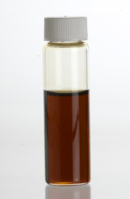Spikenard
Spikenard, also called nard, nardin, and muskroot, is a class of aromatic amber-colored essential oil derived from Nardostachys jatamansi, a flowering plant of the valerian family which grows in the Himalayas of Nepal, China, and India. The oil has been used over centuries as a perfume, a traditional medicine, or in religious ceremonies across a wide territory from India to Europe.

Catholic Church iconography uses spikenard to represent Saint Joseph. With this meaning, Pope Francis has included the spikenard in his coat of arms.
Plant sources
Nardostachys jatamansi is a flowering plant of the valerian family that grows in the Himalayas of Nepal, China, and India. The plant grows to about 1 meter (3 ft) in height and has pink, bell-shaped flowers. It is found at an altitude of about 3,000 to 5,000 m (9,800 to 16,400 ft). Rhizomes (underground stems) can be crushed and distilled into an intensely aromatic amber-colored essential oil with thick consistency. Nard oil is used as a perfume, an incense, and an herbal medicine.[1]
Historical use

The oil was known in ancient times and was part of the Ayurvedic herbal tradition of India. It was obtained as a luxury in ancient Egypt, the Near East. The Egyptians stored the oil in alabaster cases to preserve its fragrance.[2]
The name "nard" is derived from Latin nardus, from Greek νάρδος. This word may ultimately derive either from Sanskrit naladam (Indian spikenard), or from Naarda, an ancient Assyrian city (possibly the modern town of Dohuk, Iraq).[3] This is possibly related to the Hebrew שבלת נֵרד (shebolet nerd, head of nard bunch),[4] which was part of the ketoret used when referring to the consecrated incense described in the Hebrew Bible and Talmud. It was offered on the specialized incense altar when the Tabernacle was located in the First and Second Jerusalem Temples.
The ancient Greeks gave this name to a species of lavender native to coastal regions of the Mediterranean. Nard was used to perfume the body of Patroclus by Achilles in Book 18 of Homer's Iliad. In ancient Rome, nardus was used to flavor wine, and occurs frequently in the recipes of Apicius.[5][6] During the early Roman empire, nardus was the main ingredient of a perfume (unguentum nardinum)[5], and Pliny's Natural History lists twelve "species" of nardus, identifiable to varying degrees of assurance, including Lavandula stoechas and tuberous valerian as well as spikenard (Nardostachys jatamansi).
An ingredient called "nard" or "narde" was used to season foods in Medieval European cuisine, especially as a part of the spice blend used to flavor hypocras, a sweetened and spiced wine drink.[7] From the 17th century, it was one of the ingredients for a strong beer called stingo.
Religion
In the Hispanic iconographic tradition of the Catholic Church, the spikenard is used to represent Saint Joseph.[8] The Vatican has said that the coat of arms of Pope Francis includes the spikenard in reference to Saint Joseph.[8][9][10]
Nard (Italian nardo) is also mentioned in the Inferno of Dante Alighieri's Divine Comedy:
erba né biado in sua vita non pasce, |
References
- Dalby, Andrew (2000), Dangerous Tastes: the story of spices, London: British Museum Press, ISBN 978-0-7141-2720-0 (US ISBN 0-520-22789-1) pp. 83–88
- Insight on the Scriptures. Watch Tower Bible and Tract Society of Pennsylvania. 1988. p. 1017. ISBN 978-9-9997-4428-7.
To preserve its fragrance, nard, a light, fragrant, reddish-colored liquid, was sealed in cases of alabaster, a soft, usually whitish, marblelike stone named after Alabastron, Egypt, where vessels of this material were manufactured.
- The origin of most of these quotes comes from Dr. William Thomas Fernie, in his book "Herbal Simples" (Bristol Pub., 1895. ASIN: B0014W4WNE). A digital copy of the book can be read online via google books. 'By the Greeks the name Nardus is given to Lavender, from Naarda, a city of Syria near the Euphrates, and many persons call the plant "Nard." St. Mark mentions this as Spikenard, a thing of great value. In Pliny's time, blossoms of the Nardus sold for a hundred Roman denarii (or L.3 2s. 6d.) the pound. This Lavender or Nardus was called Asarum by the Romans, because it was not used in garlands or chaplets. It was formerly believed that the asp, a dangerous kind of viper, made Lavender its habitual place of abode, so that the plant had to be approached with great caution.'
- Klein, Ernest, A Comprehensive Etymological Dictionary of the Hebrew Language for Readers of English, The University of Haifa, Carta, Jerusalem, p. 427
- ""Nardinus"". Charlton T. Lewis, Charles Short, A Latin Dictionary at perseus.tufts.edu.
- "Apicius; De Re Coquinaria". Nemeton. Retrieved 5 November 2011.
- http://terrapomaria.antir.sca.org/cooking/hippocras.htm "Hippocras" from Le Menagier de Paris [The Goodman of Paris], c. 1393 Translation by Power and Colton. The translator glosses nard thus: "Nard: There are again a number of things this ingredient could be. In the early middle ages, this ingredient usually referred to a spice brought from India. There are a number of European and American substitutes for this ingredient, all probably different (and inferior) in taste from the original. It is such a minor ingredient, I suggest that you omit it here."
- "Lo Stemma di Papa Francesco". L'Osservatore Romano (Vatican website). Retrieved 18 March 2013. (In Italian: il fiore di nardo indica San Giuseppe...Nella tradizione iconografica ispanica, infatti, San Giuseppe è raffigurato con un ramo di nardo in mano, translates as "the spikenard represents Saint Joseph...In the Hispanic iconographic tradition, in fact, St Joseph is depicted with a branch of spikenard in his hand").
- "Vatican releases Pope Francis' coat of arms, motto and ring". The Telegraph. 18 March 2013. Retrieved 18 March 2013.
- "Pope stresses simplicity, ecumenism in inaugural Mass plans". National Catholic Reporter. 18 March 2013. Retrieved 18 March 2013.
- tr. H. F. Cary) (Dante Alighieri (1845). The Vision, Or, Hell, Purgatory and Paradise of Dante Alighieri. D. Appleton & Company. p. 171.)
Further reading
- Dalby, Andrew, "Spikenard" in Alan Davidson, The Oxford Companion to Food, 2nd ed. by Tom Jaine (Oxford: Oxford University Press, 2006. ISBN 0-19-280681-5).